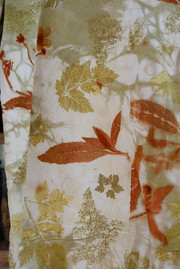Seasonal Profile: Spring Weeds
- annettebrinckerhof
- Oct 17
- 3 min read

Plant Spotlight
Wild Fennel (Foeniculum vulgare)
Native to the Mediterranean, fennel is edible by humans and insects alike. In Portugal, its feathery fronds appear widely in disturbed soil. As the season progresses, snails often consume it entirely.
Fennel is mostly known for its aromatic properties in culinary uses, but it is also highly medicinal. As a medicinal plant, it's mostly used to aid digestion. As a dye plant, I only use it for its detailed lace-like prints.
Wild Daisies (Glebionis radiata, Coleostephus myconis, Anacyclus radiatus)
Native wildflowers that blanket meadows and verges in spring. Despite being lumped together colloquially, each species has its botanical nuance. Their sun-shaped blooms lend soft, warm tones when used in ecoprint or dye baths. In Portugal, these daisies support pollinators and form part of early-season groundcover.
Ricinus (Castor Bean, Ricinus communis)
Originally native to the tropics, it grows globally and is classified as invasive in Portugal where she grows in roadsides, abandoned lots, and even planted in gardens. It's most known for its valuable castor oil used in natural cosmetics, it's also a favorite in ecoprinting: its large palmate leaves give bold impressions that are very beginner friendly. Castor leaves are available all year for me to print with, but it's in the Spring that she is featured.
Bidens aurea
Native to the Americas, this species grows in moist soils and will propagate via root and seed. I first started working with Bidens aurea because when I moved to Pct. do Ambiente it was growing abundantly between my gate and the creek. From October to June its flowers invite you to try printing with it, and it only took one experience to realize its incredible color potential - printing the most intense oranges from the stems and leaves to the white flowers. Because it is not a native host for specialized insect life locally, I can intensely harvest it from the wild with no negative effect on the local ecology. As I remove handfuls of Bidens aurea, I drop seeds for native plants like reseda and hypericum to take their place.
Reseda (Reseda luteola)
A native plant to Portugal, Reseda was historically used across Europe for its brilliant, extremely-fast yellows. In the Portuguese wild, it thrives in sunny, low-fertility conditions prefering to germinate in disturbed soils like construction sites. In the garden I have an extremely difficult time growing this wild plant so I carefully harvest from wild populations, saving and spreading seeds to encourage its propagation. In the Spring collection you'll find the reseda flowers printed on the fabric or used for the initial yellow base color.
Madder (Rubia tinctorum)
Madder is the original source of red in Europe and one of the most prized dye plants. She is known as the queen of natural dyes because of the wide range of bright, stable colors she produces. The color is produced in the roots, which must have a minimum of 4-years growth before being ready to harvest (ideally 7!). After harvesting, roots are dried and cured for a year to produce the reddest reds.
Although I technically grow Madder in my garden, I consider it a Spring weed because it has a native cousin, Rubia peregrina, which is treated as a nuisance in Portuguese gardens and also provides red. Rubia tinctorium is what I grow because of its higher red pigment concentration called Alazrin and the challenge to sustainably harvesting large amounts of roots from the wild without disturbing the soil. In 2025, after four years of letting her grow wild in large pots, madder root finally made it into the Wear Tinctorium collection for the first time.
Concept & Inspiration
Spring is a season of joy and quiet rebellion. It brings an impulse to reclaim as spontaneous plants grow through cracks in sidewalks, forgotten lots, and in roadside edges. These spring weeds are a yearly reminder that life has intrinsic value outside human design. They offer beauty, refuge, food, and dye without demanding cultivation or recognition. All they ask is not to be asphalted over in the name of 'development'. Our landscapes owe them respect, not removal.
Weeds are often seen as unwanted, but they are proof of the earth’s resilience. An “abandoned lot” becomes an oasis of biodiversity, hosting countless lives without any human effort. The world bursts into bloom in the spring; you only have to open your eyes.
The Spring Weeds Collection celebrates wildness, resilience, and the overlooked beauty that thrives without cultivation. Through the unexpected colors of pinks, reds, orange, and yellow colors of the Spring pieces, I hope to open your curiosity about the potential of color behind previously overlooked plants.












































































































Comments